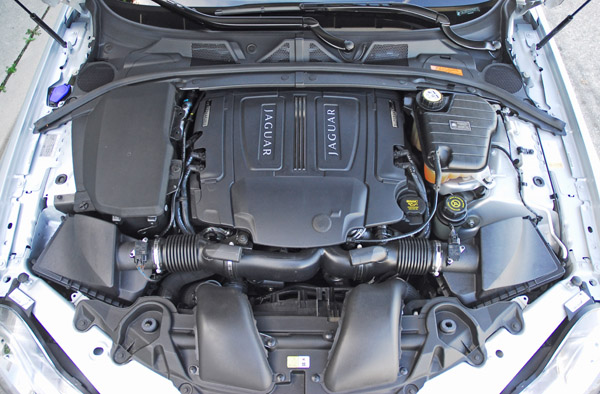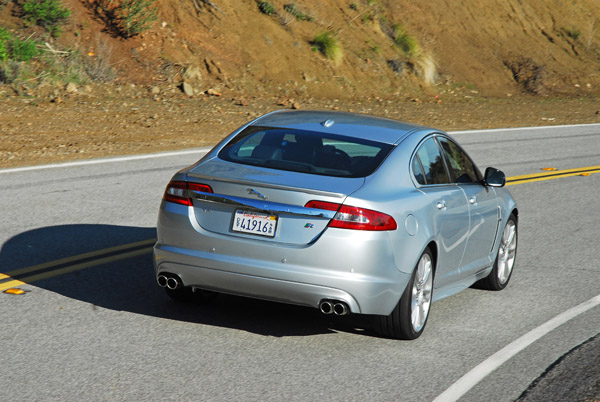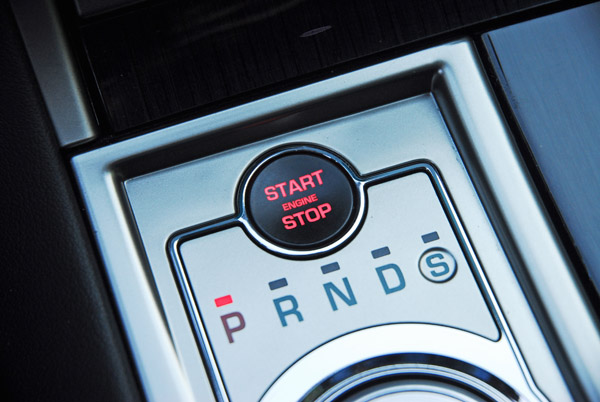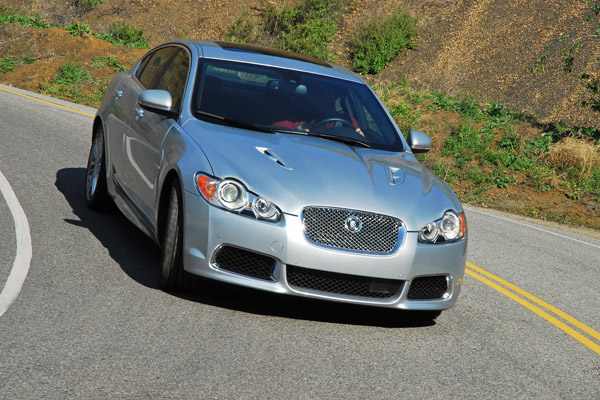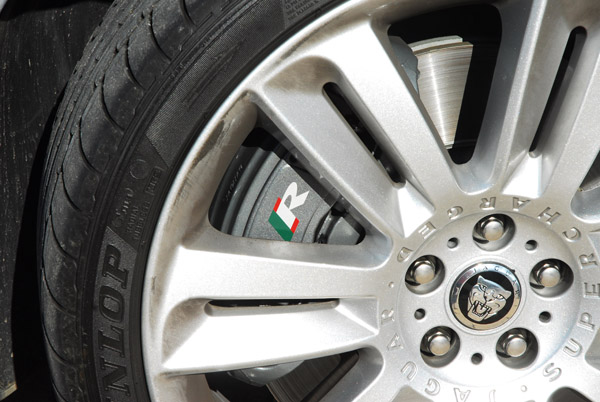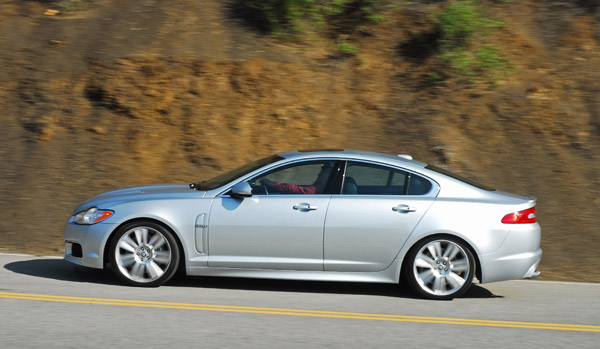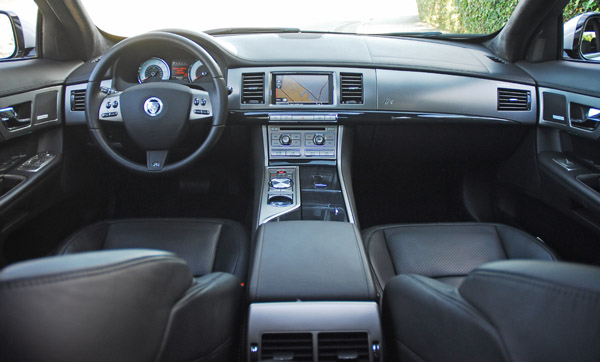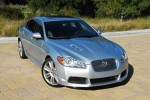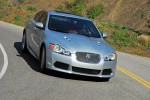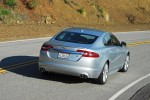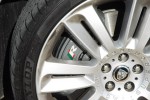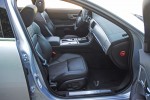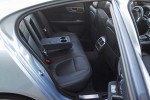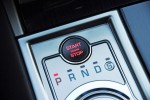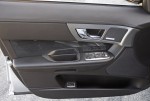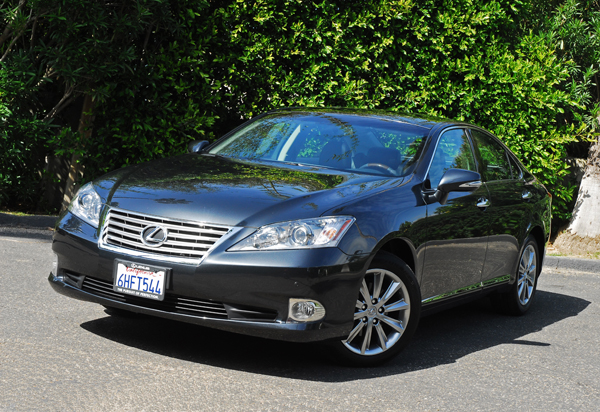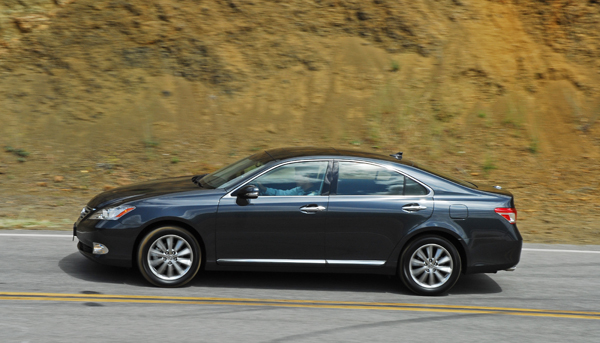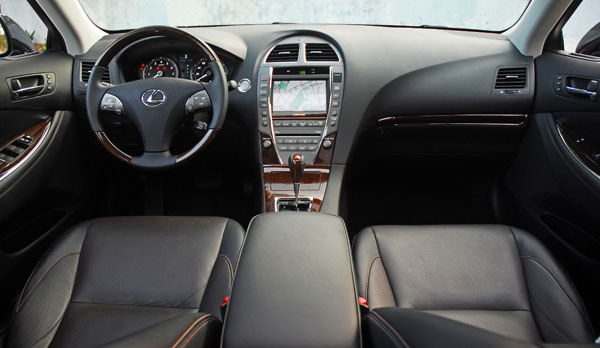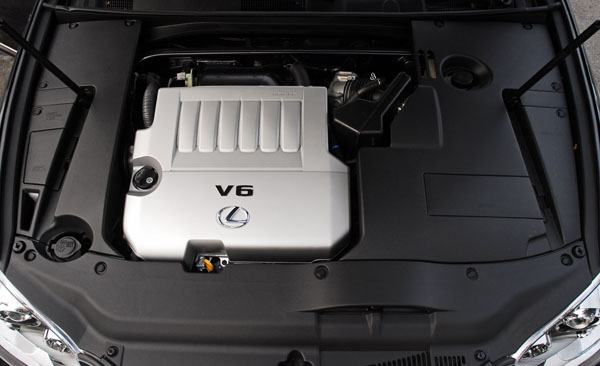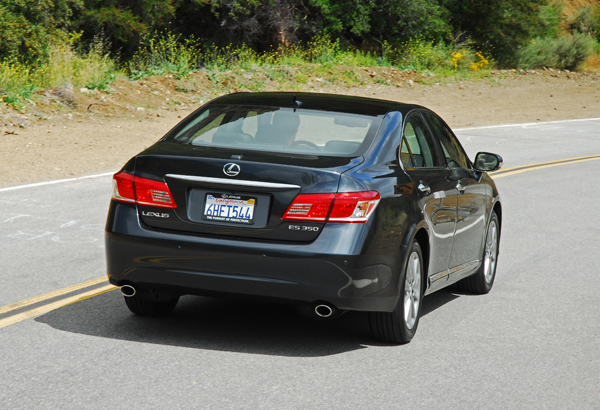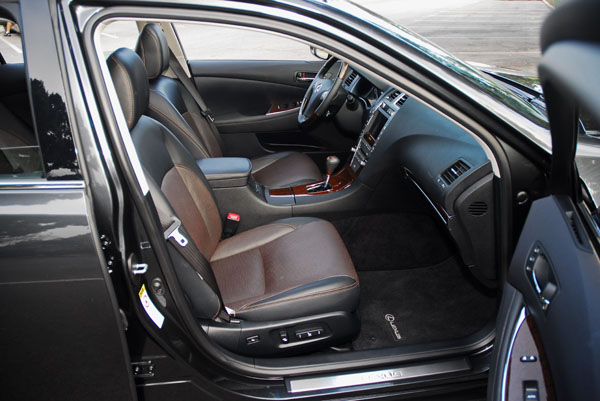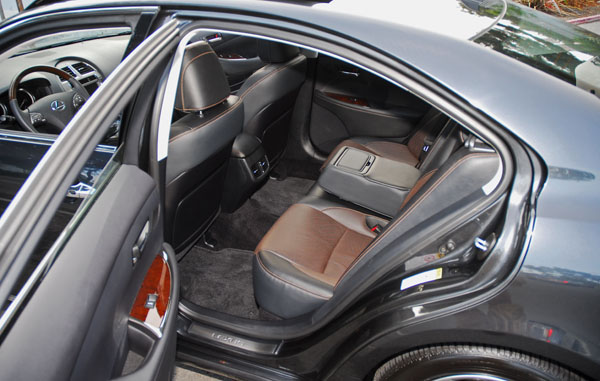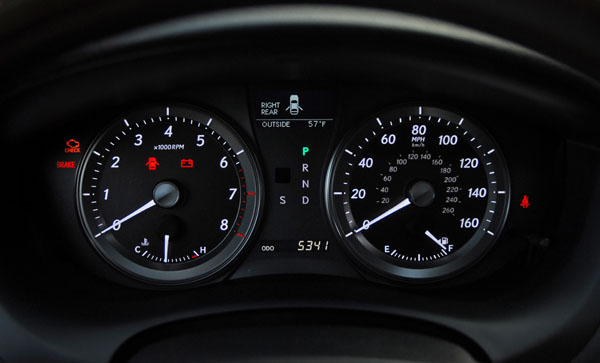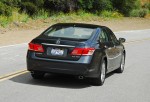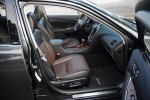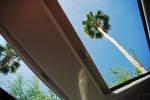Challenging the rules and standing out from the crowd, the new XFR fuses sports car styling and high-performance with the refinement and sophistication of a luxury sedan.
It is a defining example of Jaguar’s dedication to creating beautiful fast cars-and with a magnificent new engine, that are quite simply the best ever setting new standards across the board.
When it was introduced last year, the all-new XFR was soon recognized as a dramatic expression of a bold new Jaguar design language. It also soon became apparent that here as a car where the driving experience exceeded the expectations created by the striking exterior styling.
Now, the new XFR takes this driving experience to new levels, shifting the balance even further towards dynamic super high performance while still retaining the XF’s core values as a refined and luxurious sports sedan.
Immediately recognizable thanks to unique 20X9in Nevis alloy wheels with Jaguar Supercharged engraving and wrapped with Dunlop’s finest ultra-high-performance tires, a new front end design with a centered mesh grille with the Jaguar’s growling signature head, beautifully formed lamp clusters with Bi-Xenon adaptive headlamps, revised lower chrome air intake, side intakes to cool down the giant 14.9in. internally ventilated discs clamped with six-piston calipers, two working hood louvers, front fender heat extractors, four polished tailpipes, an aerodynamically functional rear spoiler, coupe-like profile with a slingshot C-pillar surrounded by a thick chrome strip, and deeper side sills, the new 2010 XFR is also the first XF to carry ‘R’ badging.
Sound quality is a key characteristic of all Jaguars and is one particular aspect that customers relish.
The new XFR has received special attention to deliver the required V8 intake sound character commonly absent on supercharged engines. Intake manifold pressure pulsations are fed into an acoustic filter at the rear of the engine that is tuned to ‘tenor C’, with the output from the filter ducted into the cabin. The filter is controlled by the engine management system which allows the acoustics to enter the cabin only under certain conditions, such as when the engine is accelerating hard, thus maintaining the desired sound quality at all times. It is music to any performance enthusiast’s ears!
Enhancing the enjoyment and thrilling ride offered by the new XFR is fully independent suspension, control arms, coil springs, gas-charged shocks and anti-roll bar up front with a multi-link rear that features coil springs, gas-charged shocks and an anti-roll bar. The new changes to the XFR’s chassis dynamics come from two new advanced technologies, Adaptive Dynamics and Active Differential Control, which gives a more comfortable, and controlled ride when needed or by turning off the system you can let the rear slide when slicing through steep curving roads.
ADC can vary its locking torque (and therefore the proportion of torque to each driven wheel) depending on surface conditions and power applied. Its control strategies optimize traction at each wheel, improving acceleration on low-grip surfaces while also enhancing cornering ability. ADC has no adverse effect on either refinement or stability-where the traditional, mechanical differential can compromise stability under hard applications of power, demanding more corrective input from the driver. Whereas a mechanical differential is permanently active, the XFR’s new ADC system is switched off when not required, so unlike the mechanical alternative, it does not risk undesirable understeer, and creates no issues with noise, vibration or harshness (NVH) at low speeds.
The differential is operated by an internal electric motor and ‘ball-and-ramp’ mechanism, and contains a multi-plate clutch, which transmits or ‘vectors’ torque to the wheel with the most grip. The multi-plate clutch assembly is designed to prevent excessive differential slip, but differs fundamentally from a conventional traction control which uses the brakes to counteract slip after it has occurred.
The three primary functions of AD are to control vertical movement, roll rate and pitch rate of the body. It does this by analyzing induced body motions one hundred times a second, and setting each damper to an appropriate level in order to maintain a constant and level body attitude, thereby optimizing control without compromising ride. Also one hundred times a second, it predicts the roll-rate due to steering inputs, and selectively increases damping forces to reduce that roll rate-improving handling feel and driver confidence-as well as analyzing fore and aft pitch rates due to throttle and braking inputs, and again varies damping forces to reduce pitch, further improving comfort and control.
Additionally, AD improves ride by monitoring wheel position five hundred times a second and automatically increases damping rate as the suspension approaches the limits of its travel. Similarly, it controls wheel ‘hop’ by varying damping to move any wheel out of a natural bouncing frequency, again benefitting ride comfort, handling and even grip.
The new XFR also features Handling functionality, which is unique in this class. In conjunction with the DSC Off option and JaguarDrive Control with Dynamic Mode, this supplements all the advantages of Traction Only Functionality with a number of more driver-focused dynamic characteristics. Dynamic Mode modifies the throttle, stability and transmission parameters, and also modifies the AD responses.
The combination of ADC and Dynamic mode with DSX Off allows controllable power-on oversteer, and improves off-throttle stability, allowing quicker, more spirited cornering when you want to take the new XFR to its limits of adhesion. It can also improve stability in situations such as an emergency lane-change maneuver at high speed and, in combination with DSC, reduce the brake interventions which the more enthusiastic driver might see as intrusive.
So working with DSC, the TCS traction control system and ABS braking function, ADC can significantly improve overall vehicle performance, and provide even more precise driving feel. It is amazing how quickly the XFR reacts to my inputs at the wheel and at the throttle when the systems are turned on or off. It is the perfect combination of electronic intervention when wanted and when no wanted to take the XFR to its limits with no electronic intervention. The perfect Jaguar!
Quickly and safely slowing the new XFR down from speed are massive 14.9in. front and 13.6in. internally ventilated power brakes. The front discs are clamped with 6-piston calipers while the rear features four-piston calipers. Enhancing braking power and control are standard ABS, Brake Assist and Electronic Brake Force Distribution. The pedal feel is very linear, a solid feel all the way from high speed to stop. These brakes completed the circle of super-high-performance acceleration and handling prowess.
The interior cabin truly matches the sportiness, comfort, and luxury under the skin of the new XFR. It is both modern, individual and uniquely Jaguar and hints at the car’s super-performance. It features a full soft grain leather interior standard including suede on the pillars and headliner. An electric sunroof to let in more air and sunlight when desired, and a new Dark Oak veneer set on the dashboard and door trim. Its new 18X14-way, heated/cooled front adjustable sports seats have newly shaped electrically adjustable squab bolsters for significantly improved lateral support at higher cornering speeds. Each XFR seat, front and rear, has the ‘R’ logo embroidered on it squab and the front seats have leather seat-back map pockets.
The leather-trimmed, heated, power tilting/telescoping, 3-spoke steering wheel feels perfect in your hand and is the right size for quick inputs. It also features its own ‘R’ logo at the bottom. The dashboard introduces a unique, dark mesh aluminum finish, and another discreet ‘R’ badge on the passenger side of the instrument panel. The easy to see instrument cluster’s speedometer and tachometer have the unique sporting signature of red dial pointers and carry the ‘supercharged’ motif. At startup, the ‘R’ logo appears on the Touch-screen as part of the XFR’s ‘driver handshake’ sequence.
The XFR also comes with the incredible Bowers & Wilkins 440-watt system with Dolby ProLogic II surround sound and 14 speakers. The Portable Audio Interface allows simple, direct connection of iPod and MP3 players with full control via the Touch-screen or steering wheel-mounted controls. JaguarSense allows touch-sensitive operation for the glovebox release and interior lights-and those lights feature soft, Phosphor Blue interior mood lighting with Halo illumination around the key switch packs to ensure easy and positive night-time operation.
Digital and SIRIUS satellite radio with HD is also standard. Other standard equipment not mentioned above includes all-express up/down windows, dual-zone climate control through the Touch-screen, electronic parking brake, variable-rate wipers/washers, center console with three cupholders, storage slots in each door, rear air vents to more directly channel cool or heated air to the rear seats including a pull-down armrest with dual cupholders, self-dimming rearview mirror, 2-person memory seats/outside mirrors, new exterior mirror design offers aerodynamic improvements plus improved functionality with its LED side repeaters, Jaguar signature door scuff plates, thick cut-pile carpeting with front and rear floor mats including the Jaguar logo leaping cat embroidered up front, dual map lamps, grab handles above each door for easy entry/exit and dual, lighted vanity mirrors.
To keep all safe in the event of a collision is standard safety features including front/rear crush zones, steel beams in each door, tire pressure monitoring system, anti-theft engine immobilizer, driver and front passenger front and side airbags, active head restraints, side curtain airbags for all outboard seats, 3-point safety belts with front pretensioners/load limiters, latch restraint anchor system, and remote security system.
The new 2010 Jaguar XFR is a ‘tour d’ force’ in super-high-performance driving with elegant, luxury on the inside. Jaguar has left nothing to the imagination to what a super performing luxury car should be fitted with-a unique, elegant and sporty exterior style, interior refinement on par with any other car in its class, and the powertrain, suspension, and brakes to back it all up. The Jaguar engineers and designers have accomplished an excellent task of bringing Jaguar’s mid-size sedan up and through ‘world-class’ driving dynamics and interior luxury. The new 2010 XFR is priced at only $79,150.00.
SPECIFICATIONS
Price: MSRP $79,150 As-Tested $79,150
Type: Large Sedan
Where Built: England
EPA Class: Midsize Cars
Dimensions
Exterior
Length: 195.3 in.
Width: 73.9 in.
Height: 57.5 in.
Wheel Base: 114.5 in.
Curb Weight: 4306 lbs.
Gross Weight: 5170 lbs.
Interior
Front Head Room: 37.1 in.
Front Shoulder Room: 56.9 in.
Rear Head Room: 37.6 in.
Rear Shoulder Room: 56.4 in.
Front Leg Room: 41.5 in.
Rear Leg Room: 36.6 in.
Luggage Capacity: 17.7 cu. ft.
Maximum Seating: 5
Performance Data
Base Number of Cylinders: 8
Base Engine Size: 5 liters
Base Engine Type: V8
Horsepower: 510 hp
Max Horsepower: 6000 rpm
Torque: 461 ft-lbs.
Max Torque: 2500 rpm
Drive Type: RWD
Turning Circle: 37.7 ft.
0-60mph: 4.7 seconds
Fuel Data
Fuel Tank Capacity: 18.4 gal.
EPA Mileage Estimates: (City/Highway/Combined)
Automatic: 15 mpg / 21 mpg / 17 mpg
Range in Miles:
Automatic: 276 mi. / 386.4 mi. / 312.8 mi









